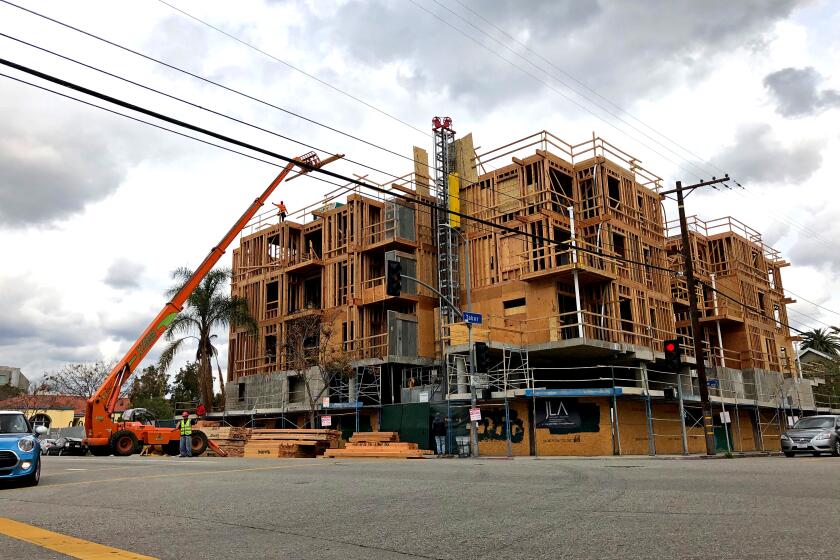Editorial: Not again. AIDS nonprofit wants to block L.A.’s ambitious plan for desperately needed housing

- Share via
Last fall, the Los Angeles City Council finally adopted an ambitious plan to help fix the city’s crippling housing shortage by making room in existing neighborhoods for nearly half a million new homes over the next eight years. So, of course, there’s now a lawsuit trying to halt the plan.
The AIDS Healthcare Foundation, a nonprofit based in Hollywood that often fights development, sued last month, arguing that the city violated state environmental law when it adopted the plan.
For the record:
2:12 p.m. Jan. 6, 2022The photo caption has been corrected to identify Drew Orenstein as the former CEO of Universal Standard Housing.
That’s the story of L.A. and much of California.
For decades, slow-growth, not-in-my-backyard opposition has obstructed much-needed housing construction, particularly in coastal urban areas, even while local economies and the population have continued to grow. That’s created a shortage that has driven up home prices and rents to levels that are unaffordable to the majority of Californians. With the problem at a crisis point, state and local leaders have started to make it easier to build new housing, but there is still strong pushback at every turn.
Los Angeles has created an ambitious plan to build more housing, especially affordable housing, throughout the city.
Just look at Los Angeles, which has committed to one of the most extensive rezoning programs in the nation. Like all cities in California, L.A. is required to produce a voluminous document, called a Housing Element, that demonstrates how it will plan and zone for enough development to house its fair share of the state’s growing population. Cities aren’t required to construct the homes, but they have to adopt laws and policies that make it easier for the private sector to build market-rate and affordable housing.
In past years, many cities have done the bare minimum, adopting housing elements that have no basis in reality and with no intention to make room for more homes. But state lawmakers have added teeth to the “fair-share” housing law and required cities to analyze and try to address housing inequality and segregation.
As part of its new housing element, L.A. identified properties that could be developed for nearly 500,000 new units of housing, including nearly 185,000 units for lower-income residents. About half of the new units could be built under land-use plans and policies that are already underway. For the rest, the city will have to rezone thousands of properties to accommodate more homes over the next three years.
California will never build enough housing as a long cities hold single-family neighborhoods sacrosanct and use local control to maintain the status quo.
In its court filing, the AIDS Healthcare Foundation argues the city is planning too much housing and making it too easy for developers to build without an obligation to provide affordable housing, which could worsen displacement and homelessness.
That’s a reasonable concern, but the housing element commits the city to study policies that will require or encourage affordable housing in new development. The housing element just sets the targets and the overarching policies — now city leaders have to adopt policies, such as inclusionary zoning or stronger density bonuses. City leaders also have to decide exactly where to rezone properties to accommodate more homes. The plan also commits the city to strengthening tenant protections and the preservation of existing affordable housing. This will be controversial and challenging work.
The last thing L.A. needs is a lawsuit that could put progress on hold. This isn’t the first time the AIDS Healthcare Foundation has attempted to slow housing construction. In 2017, voters overwhelmingly rejected a ballot measure backed and funded by the foundation that would have curtailed certain large developments. In response to that effort, labor and housing advocates offered a counterproposal, Measure JJJ, to make it easier to build taller, denser buildings near rail stations and major bus stops if the projects include affordable housing. Voters passed that measure and it has helped add 8,000 units of affordable housing to the development pipeline. (A slow-growth group sued in an attempt to block that program too.)
Los Angeles is on the right track. Let’s hope lawsuits and the inevitable NIMBY opposition that will arise as the city attempts to rezone properties don’t derail the effort to ease the housing crisis.
More to Read
A cure for the common opinion
Get thought-provoking perspectives with our weekly newsletter.
You may occasionally receive promotional content from the Los Angeles Times.












